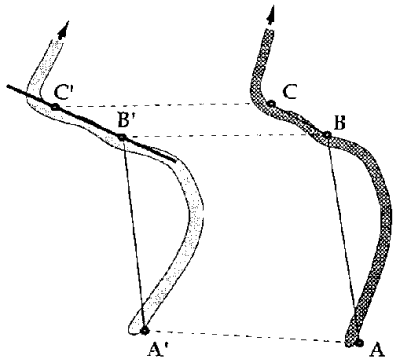 |
Science Frontiers ONLINE No. 109: Jan-Feb 1997 |
|
|
Wind-driven Ice Sheets In Death Valley
Scientists generally scoff at Forteana as beneath their dignity to investigate. But the mysterious moving rocks on Racetrack Playa in Death Valley have lured them out of their ivied halls. We quote from the abstract of a report seen in the mainstream journal Geology.
"Sharply angular boulders as large as 320 kg [700 pounds] sit on the Racetrack Playa, Death Valley, California; trails leading to them indicate that the rocks have moved large distances. The process has never been witnessed. Although high winds and a wetted surface seem necessary, controversy persists about the need for other conditions, especially ice sheets. On the basis of experiments with a wetted Racetrack surface (soft mud about 3 cm deep), we find the effective coefficient of friction to be surprisingly high, about 0.8. Movement by wind alone of moderate-sized (20 kg) rocks with cubic shape requires sustained winds close to the ground of about 80 m/s (about 180 mph). Larger flat-lying rocks require much higher winds."
The authors of this paper, J.B. Reid, Jr., et al, precisely mapped a large number of the enigmatic tracks. Their maps revealed many "mated pairs" of rocks, whose curving tracks matched near their origins to within a few centimeters, even though the tracks were separated by up to 830 meters (over 0.5 mile!). Apparently these mated rocks were locked into a huge ice sheet resting -- almost floating -- on slippery mud. Sustained winds blowing over the large areas of ice generated enough horizontal force to propel the ice sheets with their cargos of rocks. Measurements showed that some of these ice sheets had to be at least 850 x 500 m (about 100 acres!) in extent. That's big, to be sure, but hardly anomalous.
(Reid, John B., Jr., et al; "Sliding Rocks at the Racetrack, Death Valley: What Makes Them Move?" Geology, 23: 819, 1995)
Comment. If scientists would spend as much effort on marine light wheels and UFOs as they do on sliding rocks, we anomalists wouldn't have so much to write about. It's all a question of what is "academically respectable."
Reference. Sliding rocks at Racetrack Playa and other localities are cataloged at ESM11 on Neglected Geological Anoma lies. For a description of this book, visit here.
 | Two of the parallel tracks of rocks on Racetrack Playa. The parallelism suggests that the rocks were embedded in the same ice sheet. |